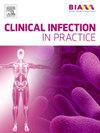一个不想要的纪念品:病例报告延误诊断球虫菌病假关节感染
Q3 Medicine
引用次数: 0
摘要
球虫属真菌是美国西部、中美洲和南美洲干旱和半干旱地区特有的二态真菌,可引起球虫菌病。虽然大多数感染是轻微的或亚临床的,可发生播散性球孢子菌病,通常影响免疫功能低下的个体。本文报告一例播散性球孢子菌病,数十年来未被诊断。病例报告:一名68岁白人女性于2024年底因发烧、寒战、呕吐和关节疼痛来到英国一家医院的急诊科。检查时,她有发热和低血压,胸部清晰,心血管和腹部检查不明显。她有广泛的既往病史,包括类风湿关节炎和结节病(用一系列免疫抑制剂治疗),以及膝关节肿胀和疼痛,为此她接受了单侧全膝关节置换术,但症状未得到缓解。在最近的报告中,收集了一系列微生物样本,包括膝盖抽吸(接种到血培养瓶中)。一种真菌被分离出来,后来被国家参考实验室鉴定为球虫。患者接受了双重抗真菌治疗,并在定期随访下终身服用抑制性氟康唑(与类固醇一起)。结论虽有广泛的流行国旅行史,且符合临床特征,但多年未确诊。最近确定诊断的实验室调查也具有挑战性,因为没有提供旅行史,而且我们的诊断设备没有用于检测这种病原体。该病例强调了在非流行地区球虫菌病的诊断挑战,强调了详细旅行史的关键作用。它还强调了与在实验室处理球虫相关的职业风险,以及需要提高对罕见病原体的认识,特别是在有相关旅行史的免疫功能低下患者中。本文章由计算机程序翻译,如有差异,请以英文原文为准。
An unwanted souvenir: Case report of delayed diagnosis of a coccidioidomycosis prosthetic joint infection
Background
Coccidioides spp, are dimorphic fungi endemic to arid and semi-arid regions of the Western USA, Central America, and South America, which can cause coccidioidomycosis. Although the majority of infections are mild or sub-clinical, disseminated coccidioidomycosis can occur, typically affecting immunocompromised individuals. This report presents a case of disseminated coccidioidomycosis that remained undiagnosed for decades.
Case report
A 68 year old Caucasian female presented to the Accident and Emergency (A&E) Department of a UK hospital in late 2024 with fever, chills, vomiting, and joint pain. On examination she was febrile and hypotensive, with a clear chest and unremarkable cardiovascular and abdominal examinations. She had an extensive past medical history, involving rheumatoid arthritis and sarcoidosis (treated with a range of immunosuppressive agents), and knee swelling and pain, for which she underwent a unilateral total knee replacement with no resolution of symptoms.
During the most recent presentation, a range of microbiology samples were collected, including a knee aspirate (inoculated into a blood culture bottle). A fungus was isolated which was later identified by the National reference laboratory as Coccidioides immitis. The patient was treated with dual-antifungal therapy and remains on lifelong suppressive fluconazole (alongside steroids), under regular follow up.
Conclusion
Although there was an extensive travel history to endemic countries, and compatible clinical features, no diagnosis was made for many years. The recent laboratory investigations which clinched the diagnosis were also challenging as no travel history was provided, and our diagnostic equipment was not set up to detect this pathogen.
This case underscores the diagnostic challenges of coccidioidomycosis in non-endemic regions, emphasizing the critical role of a detailed travel history. It also highlights the occupational risks associated with handling Coccidioides in the laboratory, and the need for increased awareness of rare pathogens, particularly in immunocompromised patients with relevant travel histories.
求助全文
通过发布文献求助,成功后即可免费获取论文全文。
去求助
来源期刊

Clinical Infection in Practice
Medicine-Infectious Diseases
CiteScore
2.10
自引率
0.00%
发文量
95
审稿时长
82 days
 求助内容:
求助内容: 应助结果提醒方式:
应助结果提醒方式:


